Or: Indiana Jones and the Green Dinosaur, a Tale of Exploration, Deduction, and Interpretation in the Wilds of Jersey City
This is the first post I made about graffiti. It went up on The Valve on November 1, 2006, over 12 years ago. When I posted this I really didn't know what I was looking at. I didn't even know that this was a name...
...much less that the name was Joe. In time I figured out that it was by Japan Joe, not Jersey Joe, and I found someone who was present when Joe did it. All I knew was that, like Alice, I'd tumbled to something wonderful, something I had to investigate. Note also that I framed the piece by a quote from Sir Gawain and the Green Knight, a great medieval poem. That still seems right.
* * * * *
“Now, indeed,” said Gawain, “here is a wizardy waste,
And this an ugly oratory, still overgrown with weeds;
Well it befits that wight, warped and wraped in green,To hold his dark devotions here in the Devil's service!Now, sure in my five wits I fear it is the foul fiendWho here has led me far astray, the better to destroy me.
–Sir Gawain and the Green Knight
Though ignorance is not, as the saying implies, a stop on the highway to bliss, it has its uses. In my case, all-but-ignorance of the world of graffiti and hip-hop has allowed me to explore my immediate surroundings as though I were a child discovering neat things in the woods, like the abandoned electrical substation where Steve and I found the raccoon skeleton in one corner of a room, or the strange markings on Timmy's lawn that looked like landing tracks from a flying saucer.
If I had been well-informed about the current state of graffiti I would not have regarded the images I recently blundered into as objects of wonder. I would have known what and perhaps even why they were and thought nothing more of them. Thus I would have been unable to see that I had found a shrine to the spirit of the triceratops. To me it would have just been a large and interesting painting (actually, a “piece”) in a strange location, strange because it is out-doors and thus unprotected, and hidden from public view as well. What sort of artist deliberately does good work in a place where no one will see it?
Tags, Throw-ups, and Pieces
The adventure started about a week ago [remember, I wrote this in November of 2006] when I decided to take some pictures of my neighborhood, Hamilton Park, roughly a third of mile (as measured on Google Earth) from the Holland Tunnel in downtown Jersey City. It's mostly a residential neighborhood consisting of one, two, and three-family attached housing and small apartment buildings. But there are large warehouses nearby, a small abandoned rail yard, a small office building for the Port Authority of New York and New Jersey, and various signs and remnants of more substantial industrial use not so long ago. It's a gentrifying neighborhood where homeless people push their grocery carts on streets where Mazdas and Range Rovers are parked.
While walking the streets taking pictures of this and that I noticed “tags” (see Figure 1) on signs, sidewalks, walls, fire hydrants, dumpsters and other surfaces.
Figure 1: Two tags on the dumpster behind my apartment building.
Figure 2: Two “throw-ups” on the side of a building, Rime and Hael
I also saw some more elaborate graffiti of the kind known as “throw-ups” (see Figure 2) - though I didn't know the term when I started this adventure. They're generally, though not necessarily, larger than tags and have filled letters, with the outline and body in contrasting colors. They take more time to make than tags, but can still be thrown up rather quickly, necessary to avoid detection by the authorities.
I uploaded the first batch of photos into my computer and began examining and editing them in Photoshop. The more I looked at them, the more fascinated I became. I decided to roam the neighborhood looking for tags and other graffiti. I didn't know what I would find, but I had every reason to think there might be something interesting out there.
After all, this “piece” (Figure 3) - as they are called, from “masterpiece” - is on an embankment about 100 yards from my apartment building. Notice the lettering to the left and right and the strange long-nosed green creature in the center. Perhaps I would find one or two other pieces like it. I now know that such pieces are common enough, and have been so for years.
Figure 3: A piece on Jersey Avenue between 10th and 11th streets. It faces east toward the Holland Tunnel, the Hudson River, and Manhattan.
For that matter I had seen elaborately painted subway cars back in the 1970s. But I was only a visitor to New York at the time, such graffiti were not a part of my world. I had read about elaborate graffiti, about competitions between “writers” (the term of art for those who make graffiti) and their “crews,” about graffiti in the high art world of Andy Warhol, about Keith Haring and Jean-Michel Basquiat. But I did not live with the work. I only visited it.
Into No-Man's Land
As I thought about the tagging in my neighborhood and about that elaborate piece around the corner, graffiti began visiting me. I got the message loud and clear when I looked through a chain link fence and saw intimations and portents at the foot of the columns (Figure 4) supporting highway 78 as it touched down in Jersey City on the way to the Holland Tunnel.
Figure 4: Column base.
Do you see those bluish tinged white areas at the bases of those columns? Something is scrawled on them, but you can't see it very well from the legal side of the fence. I decided that I had to see the tags and throw-ups on those columns. I had no particular expectations about what they would look like, up close, nor any conscious hopes for anything more. I was simply curious.
I had no trouble finding a well used hole in the fence. I got down on my hands and knees, put my camera through first, and then crawled through myself. I was off. As I approached the nearest column I knew I'd hit pay dirt. It was covered with tags and throw-ups, as were the columns near it. I snapped picture after picture, not really comprehending what I saw. I just wanted to get the photos so I could examine them at home.
I took the following photo (Figure 5) from just on the far side of a railroad overpass. The large red brick building in the distance is about 500 yards (straight line) from where I was standing when I took the photo and 200 yards (straight line) from my apartment building. It sits on a low rise about .8 miles inland from the Hudson and presides over the tool booths for the Holland Tunnel, which are midway between the building and the shoreline. The graffiti you see here - tags and throw-ups - is typical of the material that was readily visible from the street.
Figure 5: Looking Toward the River
The piece below (Figure 6) is just barely visible from the street:
Figure 6: ZAR (Old School)
The lettering is, say, six feet high. Notice that the “base” lettering is covered with tags in various colors. There is clearly some contention over who “owns” this space. Legally, of course, none of the writers and crews owns the column; it belongs to the New York Throughway Authority. Just as the letter of the law differs from the spirit, so it differs from practical effect. In this case, the public harm caused by painting in such places is small, too small to justify enforcement efforts or, for that matter, clean-up. No one lives or works in these structures, nor are they very visible. Those most likely to think of the graffiti on them as eyesores rarely, if ever, lay eyes on them. Practically speaking this land belongs to the writers, and to the homeless, and to other “interstitial” people. It is no man's land, in the middle of the city. It is a liminal space.
It is thus fitting that one relatively spare piece (Figure 7) show a flying saucer (upper left) and a “crop circles” tag (lower right).
Figure 7: Mother Ship and Crop Circles
Nor is this the only instance of an aliens motif at the site. Look at the left side of this column (Figure 8):
Figure 8: Alien
That is clearly a tall slender alien. He has companions on other sides of the column, though they are obscured by tagging subsequent to the original painting.
As I moved away from the open fields and headed north toward a more wooded area, I saw this:
Figure 9: Through the Trees
Here's what you see when you get past the obscuring trees:
Figure 10: Emergence
What is that? Historically, the design imagery in these pieces derives from lettering and cursive script. It is highly elaborated calligraphy. Here the elaboration seems to have swamped the underlying calligraphic impulse. Whatever that spirit is, it seems to gathered itself into a head that emerges at the upper left of the piece. Here's a close-up:
Figure 11: Trickster?
But what is the significance of the number “3”? Did the original writer paint the 3 at the lower left, or is that a tag by some other writer? I don't know the answers to those questions, can't even guess.
Triceratops: The Spirit of a Place
And then there is this piece (Figure 12), at perhaps the most secluded location on the site:
Figure 12: Shrine of the Triceratops
Why a triceratops? Why is this piece the one farthest from the street - though not so very far at all as Routes 1 and 9 are only about 30 yards to north of this point (we're looking south) and 40 feet up; the piece itself is on the base of a single-track railroad bridge. And what happened to the calligraphy, the “writing” proper?
Two things are obvious about the triceratops: it is large and powerful and it is extinct. As a dinosaur it occupies a certain place in our collective mythology, dark, primeval forces and all that. That is perhaps enough to give it mythic potency. And, were this picture one created on a canvas or free-standing board and intended to framing and hanging in a gallery, that would be pretty much what we have to work with, that and the formal properties of the image.
But this isn't that kind of painting. It is on a surface that is, for all practical purposes, immobile. In its general coloration it blends in with its surroundings, at least during the green seasons. It was created in and for this specific site, and so we must seek a site-specific account of it.
First a small digression. Consider this passage from Henry David Thoreau's “Sound” chapter in Walden (1854):
When I meet the engine with its train of cars moving off with planetary motion . . . with its steam cloud like a banner streaming behind in gold and silver wreaths . . . as if this traveling demigod, this cloud-compeller, would ere long take the sunset sky for the livery of his train; when I hear the iron horse make the hills echo with his snort like thunder, shaking the earth with his feet, and breathing fire and smoke from his nostrils, (what kind of winged horse or fiery dragon they will put into the new Mythology I don't know), it seems as if the earth had got a race now worthy to inhabit it.
The trope has become familiar enough, a big machine is a big animal. But what's its relevance to this site? We've got an image of a big animal; where's the big machine?
Right in front of us. The railroad bridge on which the triceratops is painted goes over a single railroad track. If you are near that image when a train passes by, you will see the train:
Figure 13: Freights (FR8s)
And there is a good chance that many of the cars in the train will have graffiti on them (see Figure 13). Not only do trains loom large in American mythology, they loom large in graffiti culture, for freight cars offer prime sites for graffiti.
Judging from my experience - I've been to the site four times - anyone who's there for more than an hour will see at least one freight train go through. Whoever painted that triceratops would have seen and heard 10s of trains in the process. On the not unreasonable assumption that this is not the first graffiti the person did at this general site, they would have seen and heard many trains prior to painting the triceratops.
Figure 14: Train approaching
My suggestion, in effect, is that the triceratops expresses or embodies the spirit or genius loci of the site. The Japanese equivalent would be kami. For example, “kamikaze” is, literally, a spirit (kami) of the wind (kaze). As an animal, the triceratops expresses the force of those huge freight hauling machines. That it is green - a most unlikely color for a triceratops - expresses the plant life that lives at the site and that contrasts so dramatically with the surrounding urban landscape.
Speculative though it is, that's my approach to the first question: Why a triceratops? Let's take up the second question: Why is this located in the least visible and accessible region of the site?
The most obvious answer looks to the practical considerations involved in writing graffiti. It is an illegal activity. Tags and throw-ups can be done quickly, minimizing the chances that the writer will be caught. Pieces take more time. The writer needs long stretches of time in which to work without fear of arrest or harassment. That puts a premium on remote locations.
Note the paradox involved. Contemporary graffiti writing originated as a way to publicize the writer's presence and prowess. The practical exigencies of the craft, however, dictate that the work requiring the most skill be done in locations where it will be least seen. Who then constitutes the public for this work? Are the writers of these pieces lone artists working only for themselves?
Perhaps, but I doubt it; that's an idea and a role that's a bit foreign to these folks. At the least, they write for other writers, as evidenced by the palimpsestic layers of tagging that exists on the pieces at this site. But the community of writers and crews is not the community of legally constituted society. It is an interstitial community, its values are different. And so its highest expressive achievements must be kept secret from that public governed by the laws, in this case, of Jersey City, Hudson County, New Jersey, and the United States of America.
And thus the practical difficulty involved in making such pieces translates into the enhancement of their value in constituting an alternative community, that of hip-hop fans, graffiti writers and their various crews and gangs. These pieces are quasi-sacred objects, perhaps not so much in what they represent (in the words and scattered images), but more deeply in their mode of social being, the way they help order the lives of the people who create them and appreciate them.
This brings me to the last question, what happened to the writing, the “stuff” that's given these craftsmen a name for what they do? There are no words or letters in this piece, which is completely constituted by the body of the triceratops. Look at this close-up of the body of the triceratops:
Figure 15: Writing on the Body
That pattern doesn't look like any animal skin I know of. But it does have a vibe similar to the complex lineation that constitutes the bulk of most pieces. I suggest that the writer who did this piece simply transcended the conventions of his - or her - medium. The writing has been transformed into regular pattern, and that pattern applied to the body of the beast. The patterning on the body of the triceratops is a stylized transmogrification of graffiti on freight trains.
A Shrine?
Am I serious in calling this The Shrine of the Triceratops? Yes and no. No: I have no reason to believe that religious rites are performed here, or that there is any explicit religious doctrine, oral or textual, associated with this site. Yes: in that the triceratops image embodies the spirit of this site, and this site is an important one for some unidentified community that I know only through evidence such as that in these few photographs.
I have selected these particular photos from some 400 or 500 that I've taken of 10s of pieces, and 100s of tags and throw-ups on some 30 or 40 columns. These few words and images only begin to convey a sense of the richness of this site.
When similar materials are found in remote places of the earth they treated as evidence of attitudes and beliefs of the highest significance to the people who made them. The fact that these markings and paintings exist in one of the most densely populated regions on the planet in the penumbra of one of its wealthiest and most sophisticated cities, that fact changes nothing. These images are the medium through which certain groups of people in Jersey City come to grips with their world. Through these images they claim the world and affirm their community.
Let me conclude with a photograph of another piece, one that is within 100 yards of the triceratops. Of what site is it the genius? Whose screams are the innocent ones?
* * * * *
You might want to stroll over to the original post and read through the comments. You'll see there how I learned a thing or two.
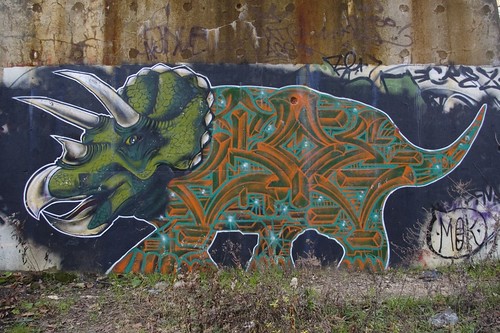
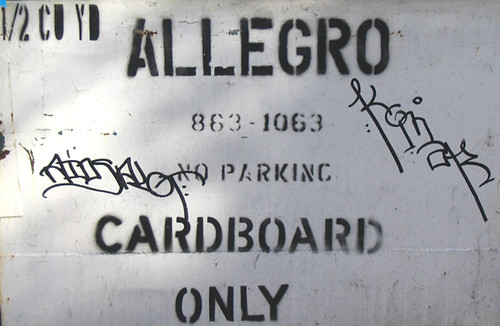
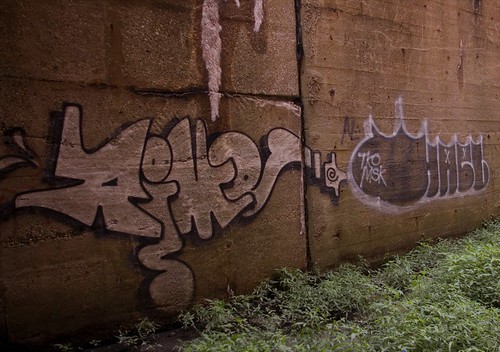
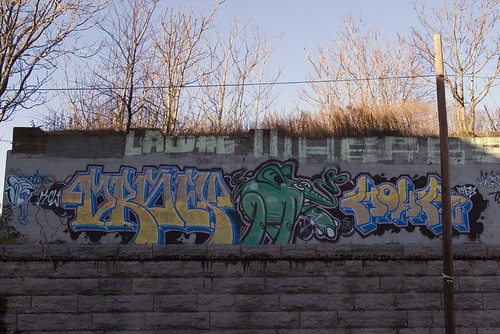
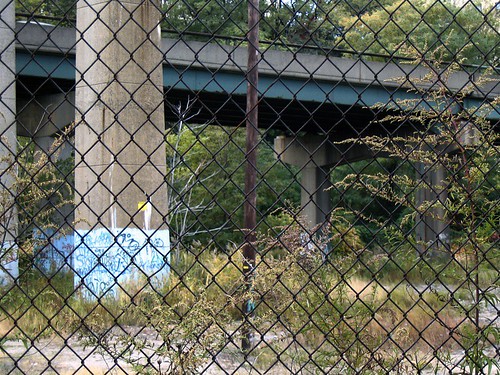
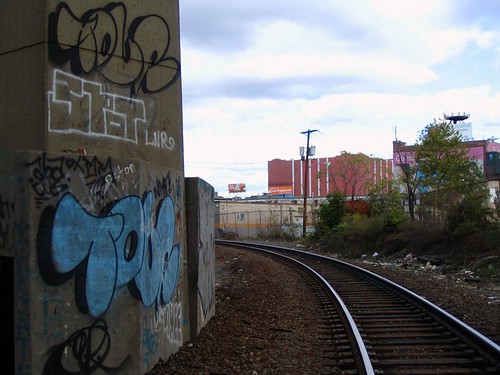

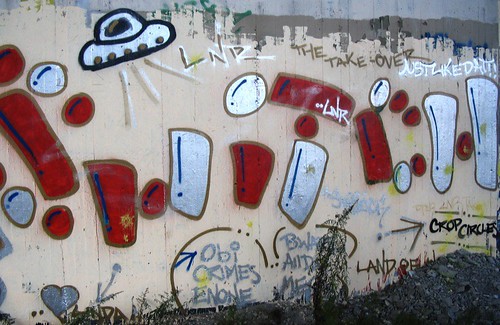
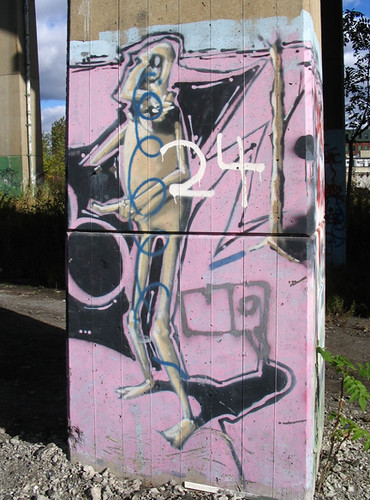
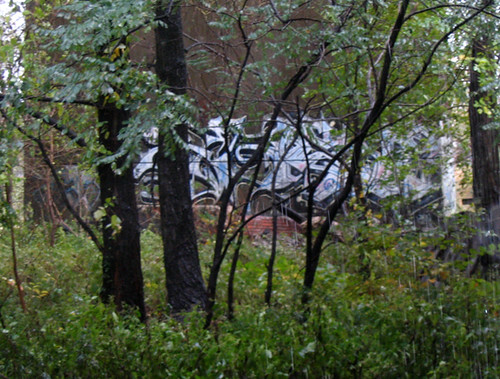
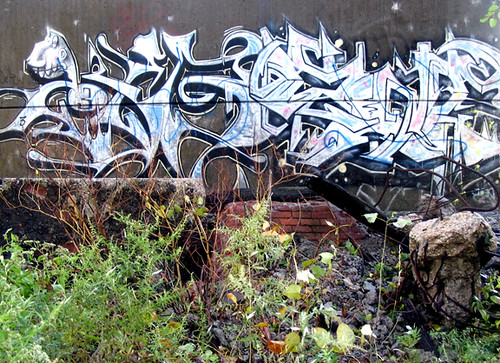
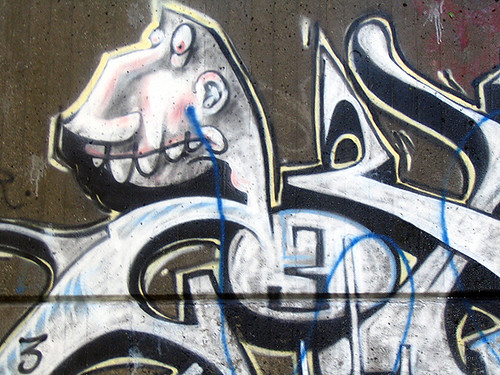

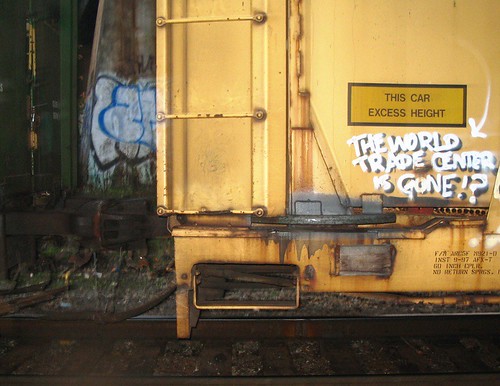
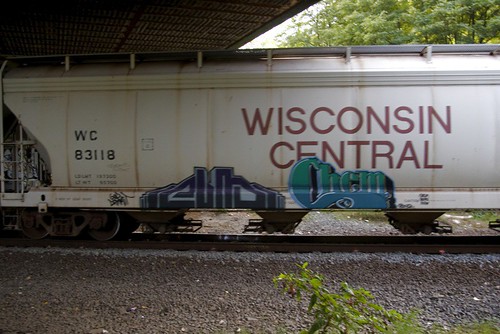
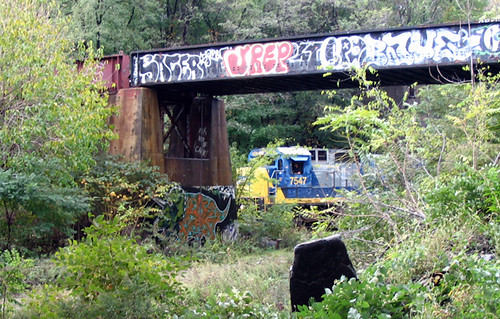
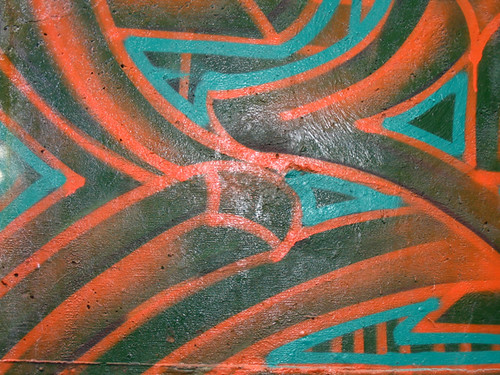
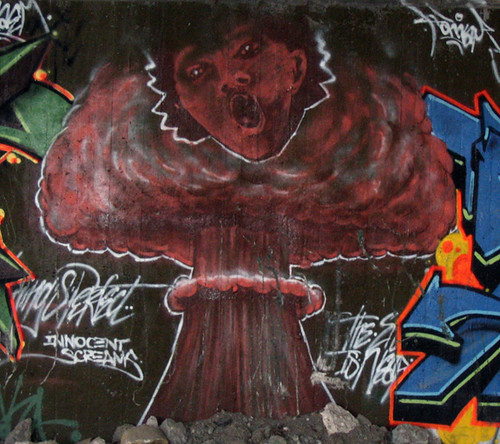
No comments:
Post a Comment